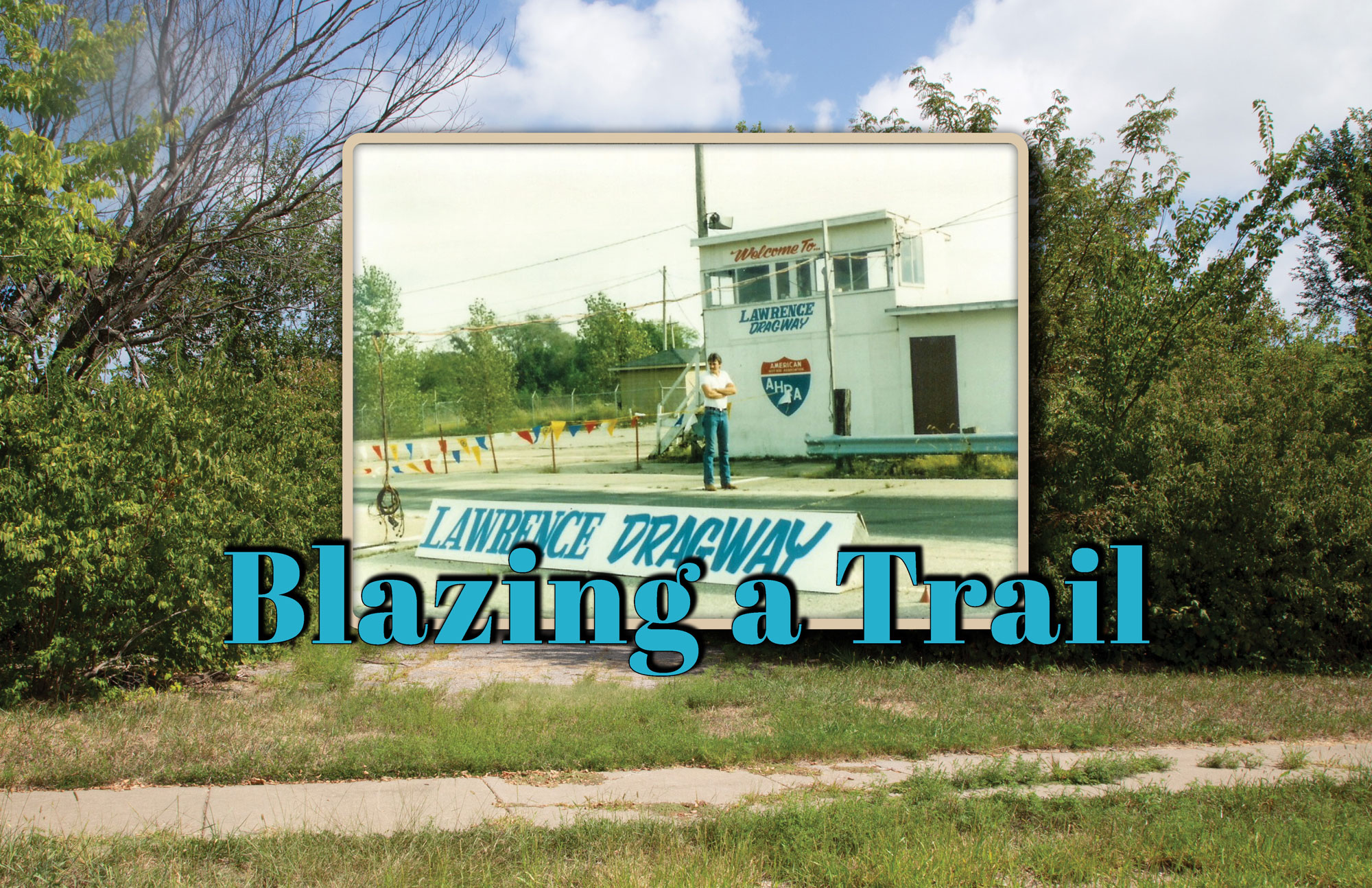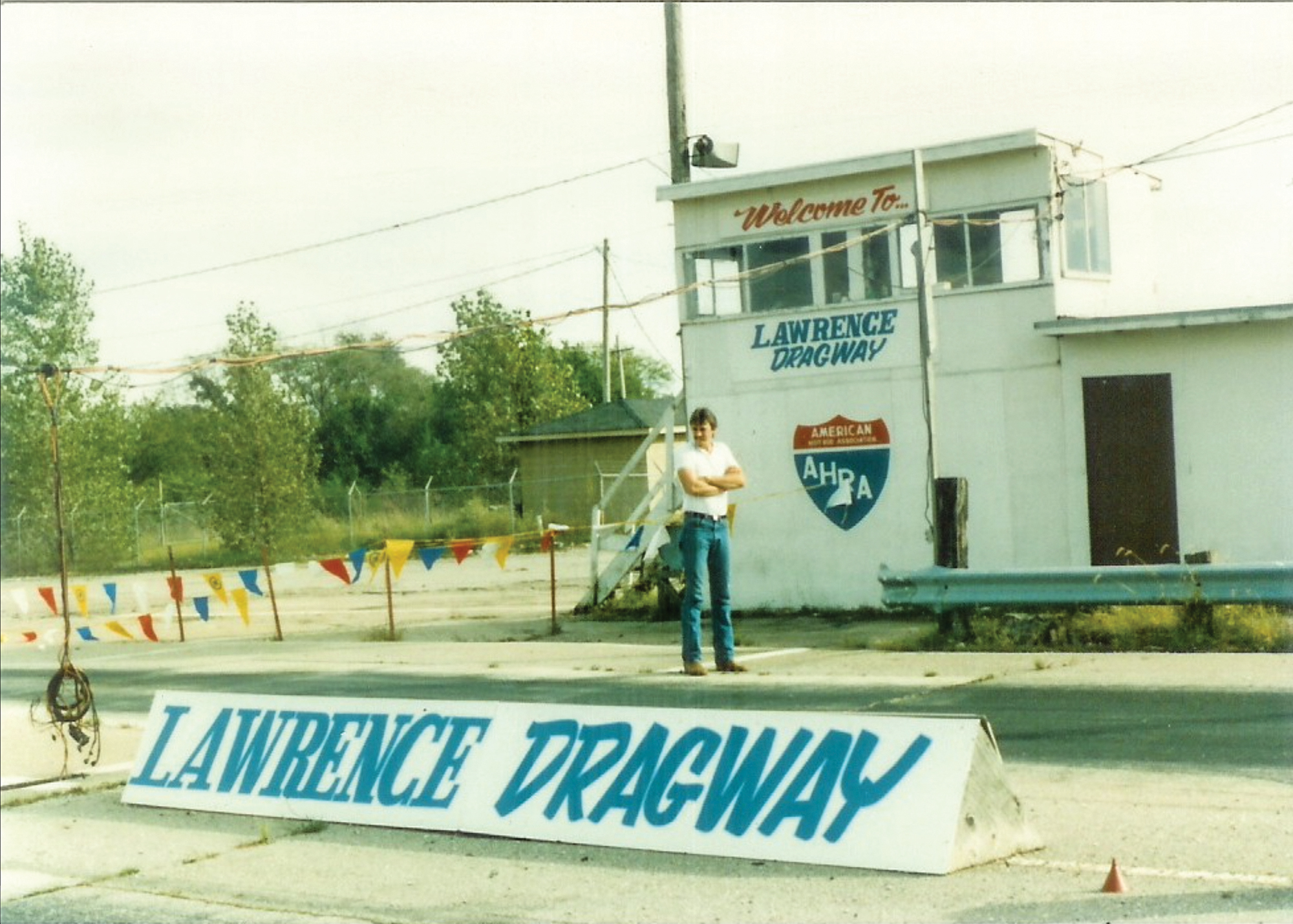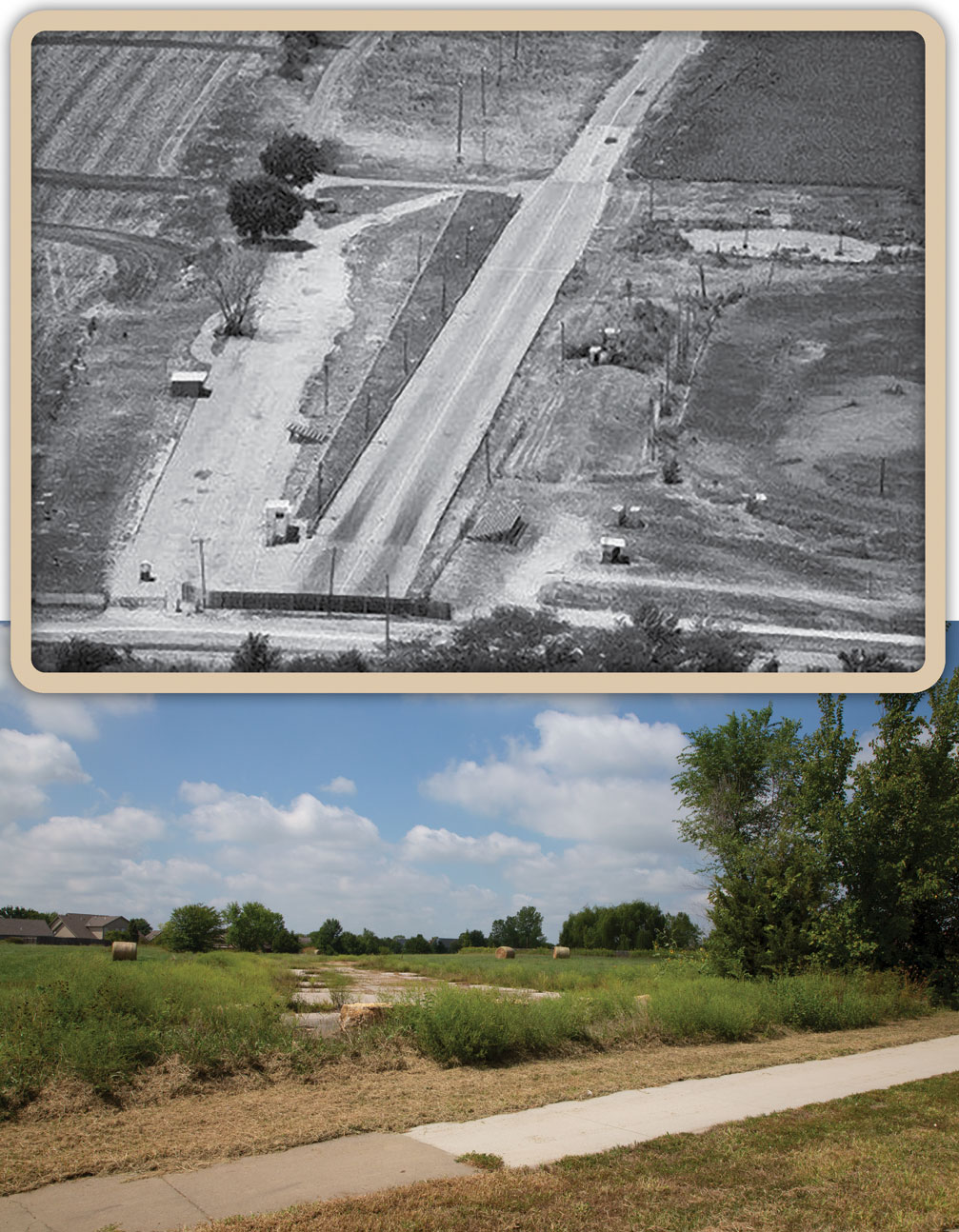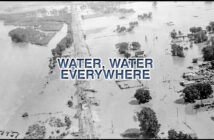| story by | |
| photos by | Steven Hertzog, Patty Curtis and Lawrence Dragway Facebook group |
| OPEN A PDF OF THE ARTICLE |
Drag Strip Road, now Wakarusa Drive, ran along a drag strip built in the late 1950s by a high school club hoping to use it as a training track.

Blazing a Trail
In 1958, William (Bill) Prince and his Lawrence High School auto mechanics club, the Crusaders Club, built a drag strip in Lawrence, Kansas. It was located 2½ miles west of the city, about three-quarters of a mile west of Highway 40. It was only an eighth of a mile long and 55 feet wide, not the standard quarter-mile track, and was considered a training track. The club spent $10,500 to build the asphalt track and hoped to make the money back from entry fees paid by competitors. The road beside the drag strip was known as Drag strip Road until 1987, when the name was changed to Wakarusa Drive.
The first races were held on Sunday, June 8, 1958, with approximately 100 cars participating. This was considered a trial run for the Crusaders Club drag strip, as timers were not yet in place. They were expected to be installed on June 15. The club held its first “Trophy Day” race on June 22 with about $350 worth of trophies awarded. Cars were assigned to classes such as “straight stock” or “modified vehicle.”

Mike Curtis circa 1986, photo by Patty Curtis
In publicizing the drag strip’s first trophy day in the June 21 Lawrence Journal World , Prince said: “It‘s a public facility, in that anyone can compete any Sunday. Only stipulations are the entry fee and the proper supervision. Any kind of car can compete and we class them according to their specification. There’s a class for about anyone.” The most important trophies to be awarded were for the top eliminator and for the driver with the top time on any of the races that day. Eliminator races were events with two-vehicle, tournament-style eliminations. The losing racer in each contest was eliminated, and the winning racers continued until only one remained. The June 22 competition had 64 entries vying for 36 trophies. The day was a success, attracting about 1,000 spectators. Don Baxter, of Lawrence, won the top time trophy driving a 1932 Ford roadster, called Old Yeller, at a speed of 106.4 miles per hour (mph). Driving a 1958 Corvette, Jim O’Brien, of Topeka, was the top eliminator.
The races continued throughout the summer of 1958. On Aug. 24, a car owned jointly by Don Baxter, Art Sommers and Rolland Hueston won top eliminator and top time honors. The car reached 108.7 mph in a 440-yard drag race. Of the 88 cars entered in the various races that day, eight vehicles were driven over 100 mph. More than 750 fans viewed the races.
The Crusaders Car Club upgraded the drag strip for the 1959 season. Lights costing $750 were installed. The length of the drag strip was increased to a ½-mile with the addition of 600 feet of asphalt paving. At the end of the paved track was a dirt track used to slow the cars after a race. The size of the dirt track was increased as the final improvement for the new season. A member of the Crusaders Club commented that having night races would make events at the drag strip more enjoyable for fans and competitors.
These improvements helped attract a national competition in 1960. The Crusaders hosted the first American Hot Rod Association Eighth-Mile Drag championships on Aug. 27 and 28. Strip creator Prince expected about 200 entrants from across the nation. The winners were to receive savings bonds as well as trophies. The prize for the top eliminator was $100, and other bonds went to the following: middle eliminator, $50; little eliminator, $50; top fuel time, $50; top gas time, $50; street eliminator, $25; and stock eliminator, $25. In addition, trophies costing more than $1300 were to be awarded. The newspaper article in the Aug. 16, 1960, Lawrence Journal World noted the trophies would be on display in Lawrence stores for the next week. The event was expected to attract some of the fastest drag racing cars in the nation.
An article in the Aug. 25 Lawrence Journal World described a couple of the cars competing in the event as follows:
- The aircraft-engined Nickelson Tool and Die Dragster, from Wichita, is an early entrant. … Bob Nickelson, the car’s driver, is currently leading the AHRA national point system and will be out for bonus points here this weekend. Another Wichita-based machine, Whitey Myers’ fuel burning coupe which has clocked at over 130 miles per hour, is in second place behind Nickelson. He’ll challenge for the coveted Top Eliminator trophy.
The club provided bleachers for these races. The article noted that the area had been “oiled” to cut down on dust. Several of the local dragsters were going to be on display in downtown Lawrence on Friday night before the races began on Saturday. Any records set during the event would be recognized by the American Hot Rod Association.
On Aug. 26, Journal World readers were provided with a short primer on drag racing so race spectators would be more informed about the sport.
- Drag racing, an automotive sport, has had a tremendous growth in the past few years in America. Timing is done by special clocks which measure elapsed time (E.T.) it takes the car to go from a stop to the end of the distance and top speed achieved by the car. Fundamentally, drag racing is a contest of acceleration in which two vehicles race from a dead stop to a finish-line.

B&W aerial photo, courtesy of Lawrence Dragway Facebook group
In addition to races, time trials, where cars were timed individually, would be held to award prizes to drivers with the fastest times. Cars were divided into classes, so similar cars would race each other for a fairer competition.
The article continued with a list of the various classes:
- There are stock cars, gas coupe sedans, street roadsters, altered coupe sedans, roadsters, gas dragsters, hot roadsters, modified roadsters, competition coupe sedans, fuel dragsters, sports cars, four bangers and fuel coupe sedans.
Definitions of these historic classes are difficult to find, as the sport has evolved into classes such as top fuel dragster, top fuel funny car, pro stock, top alcohol dragster and top alcohol funny car.
The American Hot Rod Association Eighth-Mile Drag Championships on Aug. 27 and 28 started with time trials on Saturday morning. Saturday evening included races for the stock cars and stock sports cars. One of the fastest dragsters in the U.S. ran an exhibition under the lights that evening. The car was owned by Creitz Automotive Co., of Tulsa, Oklahoma. It was a “supercharged” Chevrolet and ran on nitrogen fuel. It had been timed at a speed of 140 mph on an eighth of a mile track. Sunday afternoon would feature the “big car” eliminations. The savings bond prizes were sponsored by Marks Jewelers, Harnar Auto Supply, Dr. Pepper and the Douglas County State Bank. A number of other local businesses were sponsors of the championships. Local drivers had some success in their classes. Ron Hoover’s and Larry Stemmerman’s flathead dragster won its class, and an alcohol-altered car owned by Clifford Burgert and Harlan Miller was a class winner. It was estimated that more than 2000 people viewed the races over the two-day event.
After the excitement of the National Championships, the Crusaders Car Club purchased the newest safety devices for the cars they raced on the drag strip. They acquired four parachutes, which stopped cars in less than half the distance it took using brakes. And of course, racing continued with additional races on Saturday, Oct. 8. 1961. More than 100 entries from Iowa, Colorado, Kansas, Missouri, Nebraska, Oklahoma and Texas competed for trophies.
One Lawrence resident gained fame as a drag racer. Frederick Inyard, an African American, won a number of races during 1960 and 1961. In 1962, he won the A/Gas AHRA National Championship. He drove a supercharged Oldsmobile dragster.
The Crusaders Club drag strip was definitely successful and provided various kinds of learning experiences for its students. Bill Prince could not have imagined the impact the automotive club races would have on the community. They capitalized on the growing popularity of drag racing (Kansas had 41 drag strips at various times), and their events brought several thousand competitors and spectators to Lawrence.
This drag strip remained in operation until 1986.




